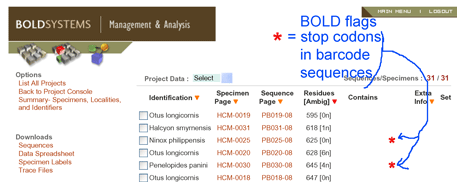 In 29 july 2008 Fish Biology scientists from Macquarie University, Sydney describe successful recovery of mitochondrial DNA from contemporary and historical shark teeth and jaws. After developing the method on 11 recently collected teeth from Gray nurse shark Carcharias taurus and Ornate wobbegong (excellent name!) Orectolobus halei, Ahonen and Stowe applied it to 20-40 year old museum specimens, including 5 jaws from 3 species and 19 individual teeth from 2 species. They collected approximately 0.02-0.06 g of “tooth powder” by drilling several small holes into a tooth or jaw; DNA was extracted using a standard silica-based method or Qiagen DNAeasy tissue kit.
In 29 july 2008 Fish Biology scientists from Macquarie University, Sydney describe successful recovery of mitochondrial DNA from contemporary and historical shark teeth and jaws. After developing the method on 11 recently collected teeth from Gray nurse shark Carcharias taurus and Ornate wobbegong (excellent name!) Orectolobus halei, Ahonen and Stowe applied it to 20-40 year old museum specimens, including 5 jaws from 3 species and 19 individual teeth from 2 species. They collected approximately 0.02-0.06 g of “tooth powder” by drilling several small holes into a tooth or jaw; DNA was extracted using a standard silica-based method or Qiagen DNAeasy tissue kit.
The authors are interested in historical population sizes for sharks; following the theory that genetic variation within species is an indicator of population size, they picked the hypervariable control region as their target. As an aside, results so far with mitochondrial surveys including DNA barcoding generally show very low variation within most animal species and no relationship between intraspecific variation and census population size. In any case, a 700 bp fragment of mtDNA control region was amplified with a single pair of primers. The two extraction methods gave similar results. DNA was amplified and sequenced from 100% of the contemporary samples and 15/34 (44%) historical samples. 700 bp is a relatively long sequence to amplify from historical samples, suggesting it may be possible to obtain standard COI barcodes (648 bp) from museum skeletons of sharks and bony fish, which would be particularly useful for those species which are rare or otherwise difficult to collect. A standard set of fish primers (see for example Hubert et al June 2008 PLoS ONE) amplifies COI barcode region from most fish (more than 5,000 species so far, including including representatives of all major divisions of Chondrichthyes (cartilaginous fish) and Osteichthyes (bony fish), both marine and freshwater).
To date most fish specimens are preserved in formaldehyde, which makes routine DNA recovery difficult or impossible. If DNA can be recovered from skeletons, there are many museum specimens that might be used. For example, the American Museum of Natural History Icthyology Department collection includes over 35,000 fish skeletons as compared to about 2,500 tissue samples so far.
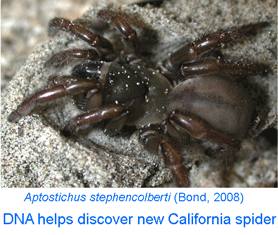 In
In  In
In 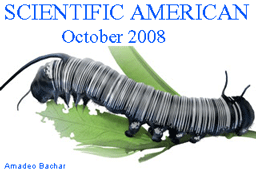 An article in
An article in 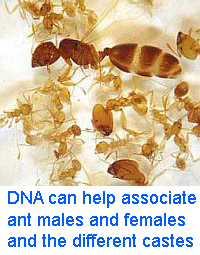 In
In 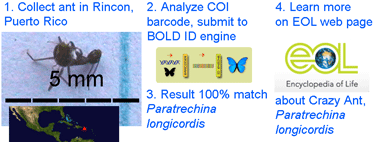 As a test of how DNA barcoding might work for the interested ant novice, I collected the tiny specimen at left in Rincon, Puerto Rico, and submitted its COI barcode to
As a test of how DNA barcoding might work for the interested ant novice, I collected the tiny specimen at left in Rincon, Puerto Rico, and submitted its COI barcode to 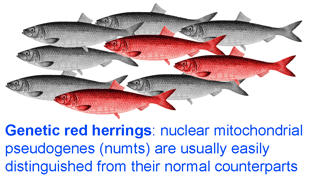 Pseudogenes, first described by
Pseudogenes, first described by 